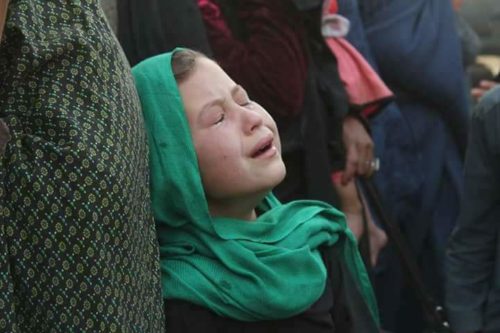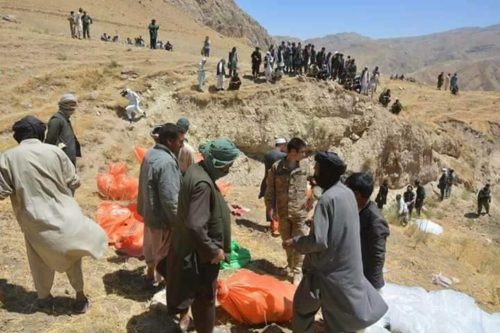by Akram Gizabi |

- Twitter: #MirzaOlangMassacre | @AGizabi
- See also: Taliban and ISIS join forces in brutally slaughtering dozens of Hazara families in MirzaOlang, Sar-e Pul, Afghanistan

What happened in Mirza Walang and why it is important?
On Friday, August 4, 2017 about 800 armed men launched a three pronged attack at a village in a remote mountainous region in northcentral Afghanistan. The village was Mirza Walang a large and densely populated area in a strategic district called Sayyad in the province of Sar-e-Pul. The attack began at midnight by Taliban and ISIS extremists from different provinces. Although the two groups were antagonistic in the past and at some points sworn enemies of each other, they found perhaps a common cause to show their enmity towards the Hazaras.
The defenders expecting reinforcement from the government resisted to the last men. Noncombatants left during the night and were stopped on their way to the center of the province. With horrible cruelty men, women and children were gunned down, decapitated or dismembered. Only five bodied were released, the rest are buried in mass graves or individually wherever they were killed. With partial access to the region the people have found several mass graves in one of which 35 people were buried. More than 150 families are trapped and surrounded by the extremists. About 80 people including women are reportedly taken hostage and transported to different regions. So far 235 people mainly children and the elderly women and men are released with the help of elders from other communities.
Why Mirza Walang and What it means?
Geographically, Sayyad district is the key area for reaching the center of Sar-e-Pul province and Mirza Walang sits on a strategic road that leads to that center. Also the area is mountainous which is not reachable by road and difficult if not impossible to reach by air. If the extremists control this strategic location the center of the province would be vulnerable to attacks. The province itself is contiguous to six provinces in northern as well as central parts of Afghanistan. These provinces themselves are important for the ring-road in the north as well as contacts with northern neighbors of Afghanistan. Balk, Samangan, Jowzjan and Faryab provinces are important for the control of the ring road and Bamiyan and Ghor provinces for central Afghanistan. Sar-e-Pul which is a relatively newly formed province is the weakest link in this puzzle with very little resources and almost no military force to defend its territory.
Ethnically, Mirza Walang is inhabited by Hazaras who were very active in the war against the Soviets and the subsequent regimes installed by the Soviets. The people are battle hardy fighters who opposed the Islamic extremists represented by the Taliban or ISIS. Several attempts by these extremists failed to dislodge the local fighters. In one offensive earlier this year, the extremists lost several dozen fighters.
The Hazaras are Shi’ites as opposed to the Taliban and ISIS who are Sunni extremists that think Shi’ites are not Muslims. In Pakistan, Syria, Iraq and Yemen the Sunni extremists are fighting against the Shi’ites for dominance.
In Afghanistan, the Hazaras are prime targets of the extremists who want to score points with their sponsors and supporters. The central government knows very well the precarious situation that the Hazaras are in but for political as well as ethnic reasons has not send any reinforcement to the region, despite repeated requests from the local people militia. The government only belatedly sent forces to the region but so far has made no headway.
Just last month the extremists took over a hospital in Taiwara in the center of neighboring Ghor province. Scores of people such as doctors, nurses and even patients were dragged out of bed and murdered in cold blood. The terrorists deliberately and painstakingly separated the Pashtuns from Non-Pashtuns. There, too, the majority of the victims were Hazaras. Is targeting a non-Pashtun a trend in the war in Afghanistan? Sadly the answer is positive.
In the case of the Hazaras the problem is mostly ethnic rather than religious. The Hazaras are targeted by the extremists both in Pakistan and Afghanistan. In Pakistan, an estimated 40 million Shi’ites are living, yet the religious extremists from Punjab province where the majority of Shi’ites are, go to Baluchistan to target the Hazaras who number only about 600,000.
In Afghanistan, only the Hazaras are targeted, while there are pockets of Shi’ites living in many major cities.
When the central government marginalizes almost every non-Pashtun ethnic group and all appointments especially the important positions are filled with only one ethnic group, it sends a clear message to everyone that ethnocentrism is the order of the day and it is alright for extremists to target the non-Pashtuns especially Hazaras. The army, the police and the intelligence are dominated by one ethnic group and they know what to do, where to send reinforcement and where not to. Mirza Walang is not the only place where pleas for sending reinforcements were refused or not heard. Couple of years back in a place called Jalriz west of Kabul several police posts came under attack by the Taliban. For 72 hours the defendants resisted the onslaught. All pleas to the highest echelon of government were ignored until all but few of the defenders were butchered by the Taliban. All the defenders and the residents of the area were Hazaras. So is it a coincidence that whenever Hazara defenders are involved, reinforcements don’t come?
Mr. Ghani in an interview before becoming president had said that 95% of the prisoners speak in one language, meaning Pashtu. Now he tries to make the palace and all the organs of the state speak the same language. So is it a surprise that one by one the non-Pashtun ministers are taken out of cabinet for one reason or other and replaced by Pashtuns? Not at all, no to those who know the nature of this regime.
And then there is the question of outside powers. Iran, Russia, China, Pakistan, Saudi Arabia, and UAE to name a few for one reason or other are cozying up with the Taliban. The US too has at times emphasized that the Taliban should brought to negotiations. Even Iran an arch enemy of the Sunni extremists helps them to further its interest in the region. Iran as the majority Shi’ite country has close relationship with Taliban and supplies them with modern weapons. The Iranians had established relationship with Mullah Akhtar Mansour, the successor to Mullah Omar. Mansour had visited Iran twice where he also met Russians and established a rapprochement with them. It was on his fateful trip from Iran back to his home in Pakistan that he was targeted by a drone. He had also visited Saudi Arabia and the UAE and his successors visited China, Russia and some live and even have a representation in Qatar.
Mansour efforts to connect with Iran and Russia resulted in some effective weapons for his group. Reports from the region say that it is the type of weapons he and his associates have taken from Iran and Russia that has given the Taliban the edge. One such weapon is the night vision machine guns that helped them on the fateful night of August 4th. The attack started at 12:30 midnight and the defenders did not have the chance as the say to “raise their heads” from their trenches. They couldn’t see anything in the dead of the night while the enemy not only saw them but targeted them as well.
There have been reports of helicopters dropping supplies to the extremists the origin of which is not known. There are speculations about those helicopters and their cargoes. Sometimes there have been Afghan helicopters dropping “things” which Afghan officials have said “by mistake” to the insurgents. Is it really a mistake or as the locals call it a “deliberate mistake”?
For Hazaras the depth of the tragedy is slowly emerging. Aside from the death, destruction and plundering of their property and belongings, some people are still missing and reportedly taken hostage and out of the area. We don’t know that will happen to these hostages which reportedly include women. In rural Afghanistan as well as in most Muslim countries, taking women as hostages is worse than any crimes that an enemy commits against his foes. Unless the government moves in with a force strong enough to secure the release of the hostages and taking the perpetrators to justice, there is no solution to this tragedy. If left unresolved it will deepen with time and will go for generations with attacks and counter attack following to take revenge.
What is worrying is that all this happens under the watchful eyes of NATO and international community. One wonders what did they go to Afghanistan for and what they are doing there now!
Akram Gizabi
August 17, 2017
Akram Gizabi
Latest posts by Akram Gizabi (see all)
- Afghanistan: Is Another Syria in the Offing? - September 19, 2017
- MirzaOlangMassacre: Depth of a Tragedy - August 19, 2017
- Two Deadly Bombings in two Days - July 1, 2016